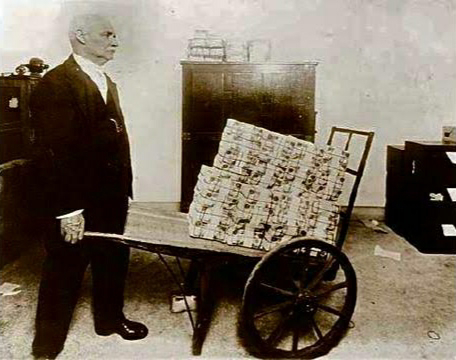The Years of depression in Germany after the crash of Wall Street (1929)
The years between 1924 and 1928 saw some stability. Yet this stability was built on sand. German investments and industrial recovery were totally dependent on short-term loans, largely from the USA. This support was withdrawn when the Wall Street Exchange crashed in1929. Fearing a fall in prices, people made frantic efforts to sell their shares. On one single day, 24 October, 13 million shares were sold.This was the start of the Great Economic Depression. Over the next three years, between 1929 and 1932, the national income of the USA fell by half. Factories shut down, exports fell, farmers were badly hit and speculators withdrew their money from the market. The effectsof this recession in the US economy were felt worldwide.
The German economy was the worst hit by the economic crisis. By 1932, industrial production was reduced to 40 per cent of the 1929 level. Workers lost their jobs or were paid reduced wages. The number of unemployed touched an unprecedented 6 million. On the streets of Germany you could see men with placards around their necks saying, Willing to do any work. Unemployed youths played cards or simply sat at street corners, or desperately queued up at the local employment exchange. As jobs disappeared, the youth took to criminal activities and total despair became common place.
The economic crisis created deep anxieties and fears in people. The middle classes, especially salaried employees and pensioners, saw their savings diminish when the currency lost its value. Small business men, the self-employed and retailers suffered as their businesses got ruined. These sections of society were filled with the fear of proletarianisation, an anxiety of being reduced to the ranks of the working class, or worse still, the unemployed. Only organised workers could manage to keep their heads above water, but unemployment weakened their bargaining power. Big business was in crisis. The large mass of peasantry was affected by a sharp fall in agricultural prices and women, unable to fill their childrens stomachs, were filled with a sense of deep despair.
Politically too the Weimar Republic was fragile. The Weimar constitution had some inherent defects, which made it unstable and vulnerable to dictatorship. One was proportional representation. This made achieving a majority by any one party a near impossible task, leading to a rule by coalitions. Another defect was Article 48, which gave the President the powers to impose emergency, suspend civil rights and rule by decree. Within its short life, the Weimar Republic saw twenty different cabinets lasting on an average 239 days, and a liberal use of Article 48. Yet the crisis could not be managed. People lost confidence in the democratic parliamentary system, which seemed to offer no solutions.





Comments
Post a Comment